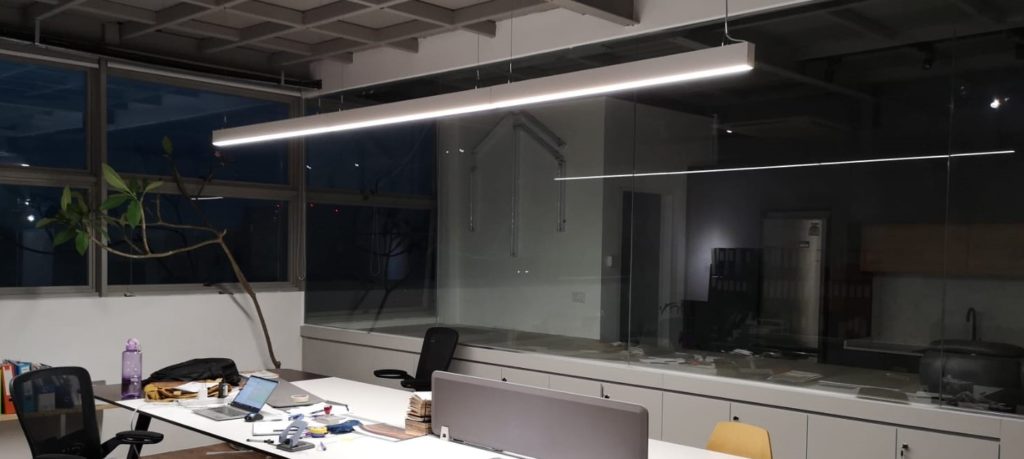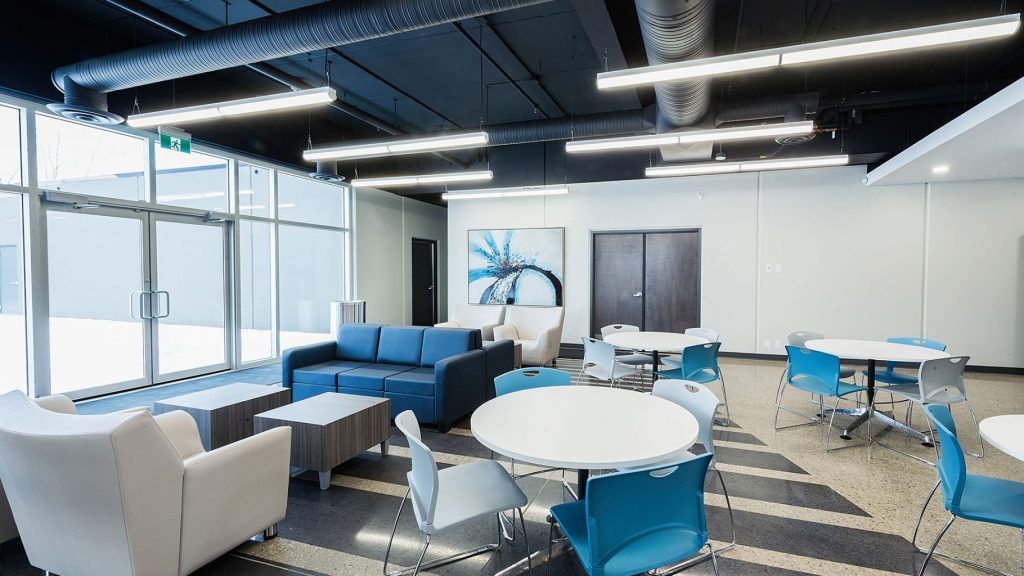Open Space Office Lighting Guide – How To Choose The Best One January 1, 2023 – Posted in: Lighting Information, Commercial Lighting, General Info, Office Lighting

Table of Contents
Open-plan offices have become incredibly popular over recent years, as the importance of collaboration and communication has become more apparent to employers. Going open-plan is not as simple as knocking a few walls down and shuffling the desks around; lighting is an aspect of office design that requires real consideration.
Before we get into the types of lighting used for open-space office lighting, it’s worth going over the benefits of doing this properly!
The Benefits of Good Open Space Office Lighting
Good led office lighting is about more than just seeing where you are going; it’s essential for the health and well-being of the people using the space. It can affect their productivity and even their happiness! Below are some of the key benefits of good open-space office lighting;
Reduced Eyestrain and Fatigue

Spending all day in front of a computer screen is a relatively new thing for humans, so it’s not surprising we’re still finding out all the ways in which it can be bad for us, and lighting is a big contributor to the negative effects of this type of work. I mean, just look at how unhappy the guy above looks!
Poor lighting in an office situation can lead to eye fatigue and strain, which can make it harder to focus on the work at hand. It can also affect people’s moods in a negative way, which in turn can affect their productivity. This brings us neatly to…
Improved Mood and Productivity

More natural light has been shown to have a positive impact on the mood and productivity of people working in these conditions, partly because it helps to regulate the body’s natural sleep-wake cycle, but also because natural light is better for our mood. By having an open space office design you allow for a more natural circadian rhythm response. Of course there is always the option of blasting 6000K lights at cubicles, but I doubt you want to be that guy or gal.
A Greater Level of Comfort

A well-lit office—but not a harshly lit one—creates a more comfortable, welcoming atmosphere for those working there. Employees who work have a welcoming space to come to every day are more likely to be satisfied with their job and less likely to leave due to unhappiness.
Good lighting can also reduce the risk of accidents and injuries in the office thanks to improved visibility. There is actually lighting standard set by OSHA that require a minimum amount of foot-candles for that reason (see Standard 1926.56).
Improved Aesthetics

A carefully thought-out open-space office can be a beautiful space that is visually appealing and inviting to those who work there or visit. It can form part of the design of the office, highlighting features and creating distinct areas within the workspace.
Types of Open Space Office Lighting
There are many types of lighting commonly found in open-space offices, each with its own advantages and disadvantages. Below are the most common types of lighting used in open-space offices;
Ambient Lighting

Ambient light is the name given to the general light level in a space. With ambient light, the light source itself is not a feature—as it would be with directional light—and should be balanced with all other ambient light sources in the space.
Essentially, ambient light should be the same throughout the office—or as close as possible—except where an accent or feature is required. This type of light can be created by ceiling lights, wall sconces, and, of course, windows. The more diffuse the ambient light sources are, the more balanced the ambient light will be.
Natural Lighting

As the name suggests, natural lighting is light that comes into the space through windows and skylights and is widely considered to be the best kind of lighting for open-space offices. Natural light provides a full spectrum of light, helping our bodies regulate their natural sleep-wake cycle.
Of course, natural lighting is more limited than other forms of lighting in that an office space can only have so many windows and skylights. If people work in the office during hours when the sun is down, no amount of windows will bring any natural light in. Still, the benefits of natural light are clear, so it pays to make the most of what you can get.
Accent Lighting

This type of lighting could be considered a purely aesthetic feature, but that doesn’t make it any less useful when trying to create an inviting space for people to work in. Accent lighting can highlight areas and features of the office, and should be used sparingly to avoid becoming more of a distraction than a feature. Examples of accent lighting that can be used in an open office are track lighting, recessed spotlights, led strips, and wall lighting.
Task Lighting

This type of lighting is designed specifically to help employees focus on the work they are doing, and includes things like directional desk lamps, and monitor light bars. This type of lighting not only makes it easier for employees to complete their work but also reduces the chance of eyestrain and eye fatigue.
Final Thoughts & FAQ
Open-space offices have become popular for good reason, but lighting is essential in getting the most out of any workspace, regardless of how it is laid out. Carefully thought-out lighting can create a warm, inviting space in which employees are happy to work, and are healthy and productive while they are there.
In short, well-thought-out open-space office lighting benefits everyone: you, your employees, your electrical bills, and so on.
How do you light open plan spaces?
Lighting open plan spaces effectively can help to create inviting and productive work environments. Natural lighting is always the best option whenever possible, but it may be necessary to supplement with artificial lighting for the times when natural light isn’t sufficient. The key is to layer light in multiple ways so that there are both higher levels of ambient light as well as spot lighting. Aim to avoid glare, shadows, and harsh spots which can be uncomfortable and impede productivity. Install task lights on desks or at communal work stations to provide extra illumination when needed while ensuring people have access to the level of brightness they prefer. Taking all these measures will ensure that everyone has an environment that is designed for optimal comfort and performance.
I have been the project manager for Modern.Place since early 2016, spending three of those years working overseas on the manufacturing & procurement side of the LED lighting industry. Constantly learning and passing on knowledge to others while excited for what the lighting industry will involve into next.

